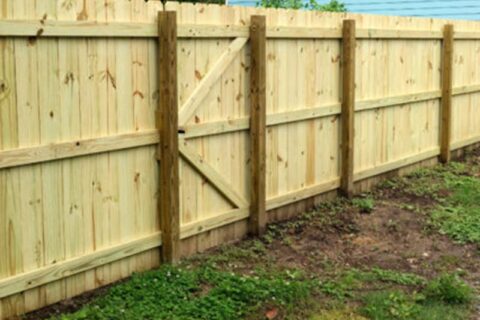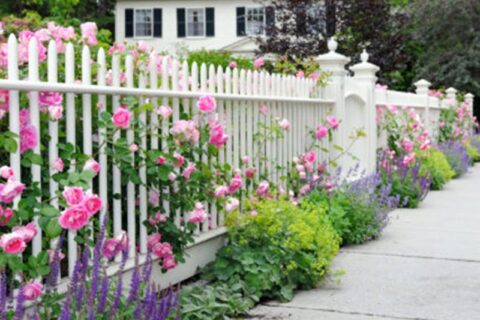How to Make a Great Garden Fence
The backyard of your house plays host to so many magical things. So many opportunities to make great memories with your family.
Areas such as a pool area, playground area, and lounging area certainly have their place. But nothing compares to going back to your roots (pun intended) with a garden.
Better yet, you can use this garden for growing several things. It can be a way to save money on groceries by eating your homegrown vegetables… what’s better than that?
Here are several different ideas on how to achieve a phenomenal garden fence that will make all of your neighbors jealous!
Types of Garden Fences to Use
Gone are the days of a garden fence with a few skinny posts and hex wire surrounding it.
If you’re going to set that type of garden fence up, you may as well not put one up at all. It’s virtually pointless, and the weather and outdoor critters will find a way through it easily.
Luckily, there are several options to build a beautiful and more effective garden fence that will protect your plants and veggies for years to come. See below for a few ideas to get started.
Also, you can consider other types of fencing if none of the ideas below suit your needs.
1. Split Rail Fence
Perhaps you’re looking for a cost-effective option, but are wanting to ensure it will be sturdy. Why not make a miniature version of one of the most reliable fences out there?
A split-rail fence will give your garden a classic and timeless farm-style look that your family and friends will appreciate.
It’s easy to set up because you can set up posts, insert the different rails through it, and have a perfect fit. Then take it one step further with mesh to ensure no animals can get in it.
Better yet, it promises to be a sturdy garden fence that won’t be waivered by weather or your big dog running into it.
The only backlash of installing this fence is that it will be hard to adjust if you’d like to expand your garden one day. Consider how large you want the garden to be, then design the fence accordingly.
2. Picket Fence With Wooden Door
This garden fence style will give your entire garden an “Alice in Wonderland” feel to it. The only way in or out will be by walking through the old wooden door.
Try to find an old wooden door for cheap somewhere in a marketplace, then design a picket fence to go along with it.
You may also add to the ambiance by planting flowers in wood planters around the outside. These will help the aesthetic of your garden as well as keep unwanted animals from slipping under the fence. A perfect match!
3. Chain-Link Fence
Maybe you’re simply looking for a durable garden fencing option that won’t break your budget. Nothing wrong with that!
If so, chain-link fencing can be as effective for protecting your garden as it for protecting your entire backyard.
It will stand the test of time, protect your vegetables and fruits, and will require little maintenance down the road. Also, if you’re looking to add a bit of pizazz, you can always add wooden posts and rails on the outside.
General Steps for Building Your Garden Fence
Now that you’ve got a few ideas of the fence you’d like to build, you’ll need to put a plan in place for how to build it.
See below for a few steps that you can incorporate into your plans, regardless of the style that you choose.
1. Install the Posts
No matter what garden fence aesthetic you choose, you’ll need to set up the posts for the fence to get going.
Start by measuring out exactly where you’d like the garden to go, and how big you’d like it to be. Carefully measure out each post location between each other before digging the foundation.
Ideally, you’ll want to dig at least 27 to 30 inches into the ground for each post to be placed into.
2. If Necessary, Install the Rails
Depending on the style you choose, you may or may not need to consider this step.
Just as you did with the posts, be sure to measure out the exact length between the posts and cut your rails accordingly. The rails are integral to the sturdiness of your fence.
One last thing to consider is the height of your rails. You’ll want your fence to be at least 3-feet high from ground to rail. Once the rails are in place, take your mesh and place it along the fence accordingly.
3. Create the Gate
Take the gate that you’ve either created or purchased (like the old wood door mentioned above) and place it into the fence.
Install the hinges to your door to the post closest to it, then install the latch and lock, if you’d like.
After you’ve installed the door, it’s time to till the area within your garden fence and start producing delicious and nutritious produce for your family!
Hire an Expert for Your Fencing Needs
If all of this seems like a bit above your handyman or handywoman capabilities, be sure to reach out to an expert to create your garden fence.
Maybe you’re considering whether or not it’s time to replace the fence in your backyard. If so, read this article on signs you need to replace your fence.
For more inquiries on our services, start by filling out our online form for a free estimate of your fencing project.


